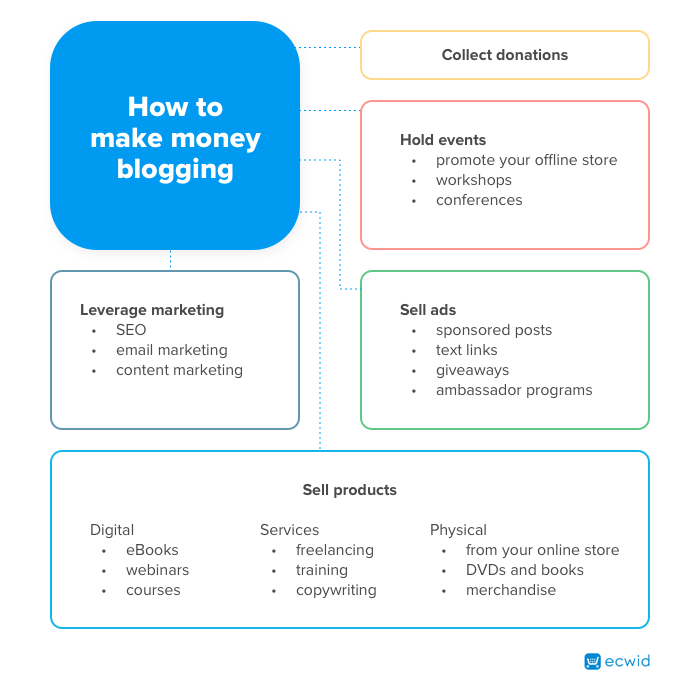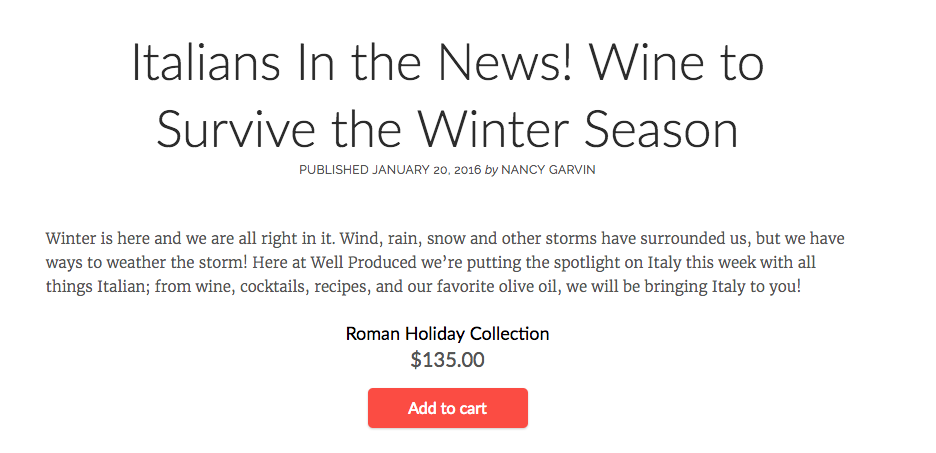Blogger monthly income reports are inspiring.
When you learn some blogs can generate $100,000+ monthly, you start wondering how exactly people make money blogging.
If you already have a blog or want to give your inner blogger a chance, you should know how you can monetize your great content. This post lists tactics that you can try in order to get rewarded for your blogging efforts.

Related: The Importance of a Blog and How to Start One for Your Store
1. Sell Your products (rather than ads)
Jon Morrow ran an experiment in CopyBlogger once:
They tried to replace their
Not only can ads be less profitable, many people simply don’t like them. Compare these web pages.

Ads distract from the blog topic because they are not relevant and are placed right in the text

This blog is about wines and sells wines right in the articles
With Ecwid, it’s easy to embed products anywhere on your page, so you can start making money with your blog even faster than you’d do with ads.
Learn more: “Buy Now” Button: A Simple Way to Monetize Your Blog
2. Collect Donations
Donations are perfect for testing your business model. If you are about to start blogging for business, a “Donate” button will look natural even if you’ve only got little content. You probably shouldn’t expect any magic here — this tactic works for some businesses and is completely useless for others. But you should totally test it.
Some tools you can use, are:
- Ecwid Ecommerce
- Kickstarter (collecting money for larger objectives)
Think of a creative CTA (Call to Action) that might be a game changer. Try different options, for example, many bloggers use “buy me a beer” instead of “donate”.
Your copy for this section should also explain why someone should give you money. This is probably the most important part. You don’t want to look like your goal is to only make money with your blog — show how you’d spend it on developing your project.

WP Candy donation page
3. Sell Native Advertising
If someone pays you for the placement of valuable, relevant content in a format similar to your blog’s, that’s native advertising.
This type of ads is far less annoying and way more effective than regular ads. Sometimes you cannot even tell native advertising from real content.
You’ve probably heard of “The Message” — an
Native advertising can take different forms:
- Sponsored posts
- Relevant content recommendations
- Podcasts
- Videos
- Sponsored listings
No matter what type you choose for your blog, you have to clearly mark it as “sponsored” content.
4. Leverage Content Marketing
Content marketing is exactly what making money with a blog is all about. Your blog should be a process of creation and sharing online materials that does not explicitly promote a brand but is intended to stimulate interest in its products or services.
This process is broken down into the following stages:
- Engaging your audience with quality content
- Improving your search results with related keywords so that more people can find your blog
- Making them buy your products in a natural,
non-pushy way.
Content marketing can take time before it starts bringing significant results and letting you make money with your blog. Many attempts may fail before you understand how to bring value to your specific audience. To get direction, notice that a great piece of content can be described as a solution to a problem + unique perspective + expertise + clear form.
Related: How to Create and Sell Your First
To get higher ranking, don’t forget to:
- Use keywords: Throughout your blog posts, use words and phrases (related to your product and what you are selling) that people would typically search for. By doing so, your site will rank higher in search engines.
- Link back: Linking (especially to your online store) in your blog posts is important. Not only will you direct potential customers to buy your products, but it will give you additional SEO juice.
- Use images: Blog articles with images get 94% more views. With that said, be sure to include images throughout your blog posts. You can use pictures of your products or images that will make your blog visually appealing. Be sure to name the image files in a way that includes your product name or the key phrases in your post.
As soon as you receive positive feedback (growing views, likes, comments, shares), you can start selling on your blog. Ecwid merchant Spencer from Thailand Amulets shared how he’s doing it in comments to another Ecwid blog post.
If you look at my shop, you will see that every “product” is not a product. What it really is, is a very long blog post which talks of all the good things in the products and things which are related to the product. It tells a long story about it

Spencer writes blogs instead of ordinary product descriptions
He blogs inside the Ecwid product editor, which has a great number of tools for it: embedding videos, formatting texts, using tables, lists, and linking.

Spencer is happy to make money blogging with Ecwid:
I just grew up as a blogger sort of thing and when I found Ecwid I just continued blogging with it. To me, Ecwid is not an
Why don’t you try? Open an Ecwid store →
5. Hold Events
If you gain a significant audience, your readers will be happy to appear at your meetups to chat in person. Offline meetings can turn your readers into customers, and customers into friends. Every business needs such strong support.

A meetup with Ecwid merchants in Moscow back in 2014
Besides meetups, reasons to meet offline are numerous. It can be:
- Visiting your
brick-and-mortar store for a special offer - A party
- A workshop
- A conference
- A degustation
- A contest or competition.
How does it help to make money with a blog? You can collect contacts, engage people with your brand story and distribute product samples, show your expertise by teaching them on workshops, and motivate them to spread the word. All that inevitably leads to getting more sales.
6. Get Affiliate Income
Affiliate programs generate passive income. You don’t really have to do anything after you partner up with another company and place affiliate links through your blog. When someone purchases your partner products via a link, you get paid.
Here are some options to get affiliate income and monetize your blog:
- Sign up for Amazon Associates to get paid for promoting Amazon products
- Sign up for the Ecwid affiliate program to earn money for recommending Ecwid to your readers
- Use LeadDyno to run your own affiliate program in Ecwid.
Almost every large company has its own affiliate program, so you can find one that is the most relevant to what you’re blogging about.
***
Those were just a few ways to make money from blogging. You might know more — so please share with us below! We would also love to hear how blogging works for you.








